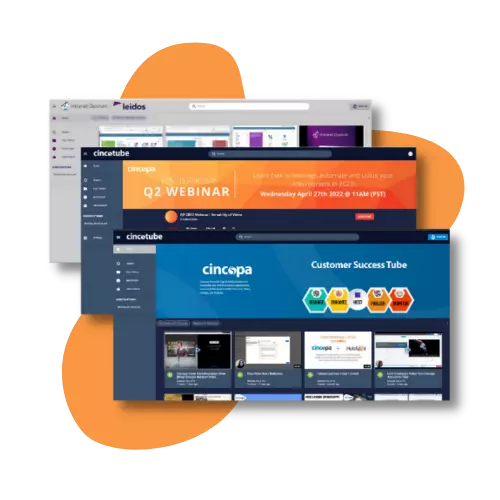Today’s enterprises are increasingly using videos for many different purposes – employee training, product demonstrations, live streamed events and executive communications. YouTube is usually the first platform they look at for sharing video content. It’s free and has extensive reach, but it also has a number of limitations and is not designed to fulfill enterprise-specific needs.

What is enterprise video?
Enterprise video comprises various technologies that organizations and their employees can use for receiving and sending video assets. It may include solutions such as content delivery networks (CDNs) for distributing high-quality videos of all kinds. It also enables live streaming, broadcast programming and video on demand (VOD).
Important enterprise video platform features
Managing and using videos effectively allows enterprises to reap the most benefits and maximum ROI. There are some key features to look for when deciding on an enterprise video platform.
Customizable video player: A video player should have more than just basic features and allow for customization to suit specific business purposes. An enterprise should be able to use the logo and colors of the brand and settings to control the viewer experience.
Live video streaming: Enterprises need to be able to live stream videos for real-time interaction with both internal and external stakeholders. Streaming high-quality, low latency video is essential across multiple and possibly distant locations. Audiences should be able to interact through live chat.
Digital asset management: Enterprises need to store large amounts of video, and centralization is necessary for users to quickly find and retrieve the videos they’re looking for. Organization of videos into categories simplifies accessibility and enables sharing with individuals, groups and on other platforms. Videos may need linking with other digital assets such as documents, audio, images or presentations, so a platform must support them too.
Security and compliance: One of the main concerns for any enterprise is the security and privacy of its digital assets. A video platform meant for enterprises needs to have extensive and robust security features. These should include end-to-end encryption, controlling access and permissions, and enabling legal compliance.
Artificial intelligence (AI): The use of AI enables various valuable functions, such as metadata extraction for creating auto-tags to improve search, automatic transcription, sentiment analysis, and much more. AI can reduce errors, add more value to videos and improve ROI.
Media analytics: Detailed video surveillance is important for enterprises to measure the effectiveness of their video content. They need to see how viewers engage with videos and gain insights to help them make informed decisions.
Integration with applications and infrastructure: Enterprises usually have many business applications and IT infrastructures, such as the cloud and CDNs. A video platform needs to offer integration with already existing applications and infrastructure for higher interoperability.

Why YouTube may not be the best option for enterprise video
YouTube has privacy settings to minimize the chances of the wrong people gaining access to internal videos. However, hosting internal-facing videos on YouTube may just not be secure enough. It opens an enterprise up to the risk of confidential information falling into the wrong hands.
Privacy settings: An enterprise can make a video only visible to certain people by adding their email addresses within the privacy settings on YouTube. However, doing so could make that video content hard to share with more than a few people. Anyone wanting access to private company videos would need permission to view them. Those permissions could easily be accidentally shared, and this solution doesn’t scale well for large teams and companies.
Terms of use: Enterprises have to give YouTube a royalty-free license and the right to copy when they upload their videos. This means that they do not have full control over their own video content. Generally, private videos will remain private, but the terms may make an enterprise vulnerable or non-compliant with regulations depending upon the industry.
Advertising, limited branding options and limited analytics: Another reason YouTube may not be the best solution for enterprise video is that it is full of advertising which can detract from corporate videos. Enterprises only have limited options for branding and customization of video channels and players, which can impact a viewer’s experience. YouTube does offer analytics, but they don’t include in-depth data about engagement. High view counts do not necessarily translate into more revenue. Getting videos to a targeted audience is often more important than getting high view counts.

How to keep content safe
As cybercrime increases and more employees work remotely, the proper protection of video assets is more important than ever. Robust security measures are required by enterprises to keep confidential information safe.
Advanced encryption: Cyber attacks can result in huge financial losses and damage a brand’s reputation. It is important to use encryption for sensitive data, such as Advanced Encryption Standard (AES).
Compliance with regulations: A video platform should fully comply with GDPR and regulations, as a lack of compliance can result in heavy fines.
Password protection: Password protecting videos can control who watches them and allow only authorized individuals or groups to view them.
Restrict access with permissions: Enterprises can give users permission to view certain videos and restrict access to others.
Prevent downloads: Bypassing security settings is possible on browser-embedded videos by right-clicking and saving a file. Disabling the right click menu can prevent this.
Domain and IP whitelisting: This restricts where users can embed video players and watch videos which can prevent internal training videos from leaking. Domain lock prevents videos from being embedded on external websites.
Proprietary video streaming: This means only a specific video player can decode the video stream from the server.
Single sign-on (SSO): Restricting viewer access to single sign-on is a way for enterprises to create an internal video content hub. Users need a single username and password to access a secure video portal.
CincoTube – for enterprise video
CincoTube offers a secure, enterprise-focused alternative to a free consumer-facing platform like YouTube. It’s designed as a private hosting and sharing solution for internal and external video that’s as easy to use as YouTube. It offers all of the above security measures and more.
Customization: Customizing digital assets is easy on CincoTube with branding and watermarks. This can prevent competitors from using enterprise videos as their own.
Public and private video channels: Corporate videotube allows enterprises to create their own video channels. Different video channels give enterprises more control over their video assets. They can create public or private channels.
A public channel could contain content for customers and enable sales and marketing teams to easily access the right video for customers at each stage of the buying journey. A private channel could contain internal training material for employees. Segregating content also allows enterprises to have a designated space where third-party contributors can upload content.
Conclusion
YouTube may be a free video-sharing platform with extensive reach, but it isn’t the best option for hosting enterprise videos. The platform was not built for business purposes and has limitations, especially when it comes to the security and privacy required by enterprises today. An enterprise-focused platform like CincoTube not only provides the most comprehensive way to store an unlimited amount of digital assets in a central location and leverage powerful search features but offers robust privacy and security.











